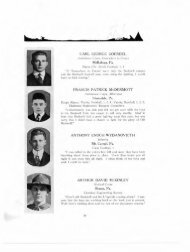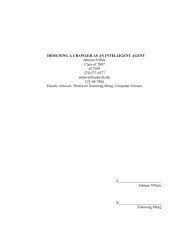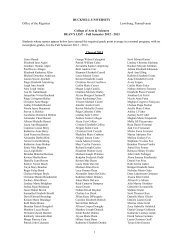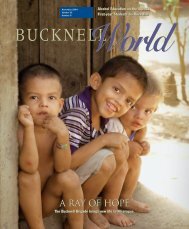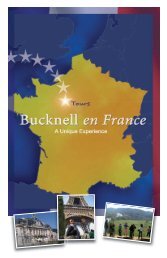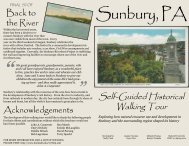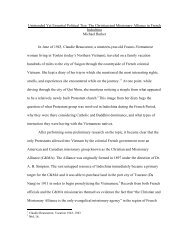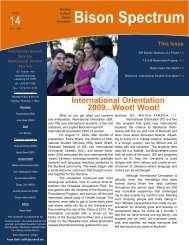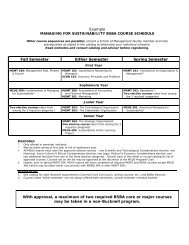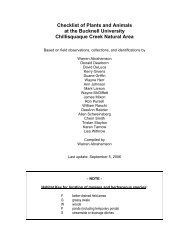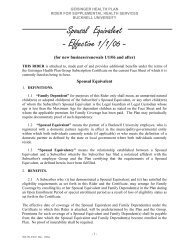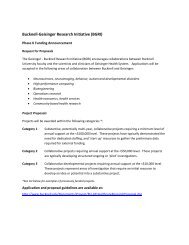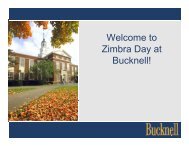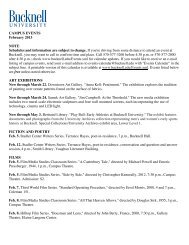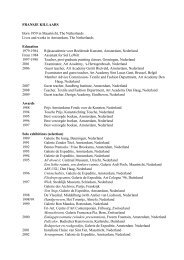World - Bucknell University
World - Bucknell University
World - Bucknell University
You also want an ePaper? Increase the reach of your titles
YUMPU automatically turns print PDFs into web optimized ePapers that Google loves.
RESEARCH & TEACHING<br />
Making a Better Bot<br />
’RAY BUCKNELL<br />
6 BUCKNELL WORLD • September 2006<br />
The Plan for <strong>Bucknell</strong> calls for<br />
building bridges to the world. Mechanical engineering<br />
professor Keith Buffinton is doing just<br />
that by involving students in real-world research.<br />
Buffinton oversees the Pulse Width Control (PWC)<br />
Project with his colleague, <strong>University</strong> of Washington associate<br />
professor Martin Berg. Funded by the National Science<br />
Foundation, the project is involved with developing precise<br />
control of robotic devices.<br />
As demands increase for finer and finer scale movements,<br />
friction presents a serious challenge to robotics.<br />
“When you’re trying to do really small maneuvers, even<br />
small amounts of friction can cause you not to reach your<br />
goal,” Buffinton says.<br />
Countless variables affect friction, making it difficult<br />
to predict how much force is needed to move a robot arm<br />
precisely to the spot where it has a job to do.<br />
Pulse Width Control offers a way to deal with the<br />
uncertainty of friction. Rather than pushing a robot arm<br />
along until it reaches its destination, a series of pulses are<br />
given to the robot, like giving a coffee mug a push across a<br />
table and then waiting to see where it comes to rest. If the<br />
mug — or robot arm — doesn’t end up where you want it,<br />
then another push is given. The key is for each push to be<br />
just strong enough to overcome friction.<br />
The PWC project is an outgrowth of work that<br />
Buffinton and Berg did on a large robot used by the Boeing<br />
Company in Seattle to construct airplanes. The real-world<br />
application gave them an opportunity to test their ideas.<br />
“It was a way for us to demonstrate that the idea, the<br />
concept, the theory really worked with a real robot,”<br />
Buffinton says. “Now we’re trying to take the same idea<br />
and expand it for different types of applications, for different<br />
types of robots, and to make it more flexible.”<br />
One way that Pulse Width Control could be more flexible<br />
is to design a system that can respond to changes in the<br />
• Tulu Bayar, assistant professor<br />
of art, was awarded an international<br />
Artist-in-Residency position at Camac<br />
Centre D’Art in Marnay-sur-Seine,<br />
France, and spent the spring there<br />
working on a new project. Bayar, a<br />
photographer and multimedia artist,<br />
completed her new work, “Addicted,”<br />
a performance-based multimedia<br />
installation, and presented it at Camac<br />
to an audience from Paris, Bordeaux,<br />
and the Champagne-Ardenne region<br />
in France, as well as to a panel of<br />
international curators.<br />
• Buoyed by a school-record<br />
eight Patriot League championships<br />
in 2005–06, <strong>Bucknell</strong> captured the<br />
Patriot League Presidents’ Cup for the<br />
12th time in the 16-year history of<br />
the conference. The Bison compiled<br />
115.75 points in the Cup standings,<br />
the most ever for <strong>Bucknell</strong> and the<br />
third most in league history. Army,<br />
the only other institution to have<br />
won the Presidents’ Cup, was runnerup<br />
with 108 points. In addition to the<br />
league’s all-sports trophy for both<br />
men and women, <strong>Bucknell</strong> won the<br />
women’s trophy for the 12th time.<br />
The Bison women set records for<br />
points earned and margin of victory.<br />
From left to right, Katie Hoffman ’08, Keith Buffinton, Christian Hubicki ’07, and<br />
Chris Shake ’09.<br />
factors that affect a robot’s performance, such as temperature<br />
fluctuations, or picking up an object.<br />
“We’re developing an adaptive controller, so rather<br />
than having to know all the system parameters precisely,<br />
we have a controller which learns the parameters as it does<br />
maneuvers,” Buffinton says.<br />
Students are integral to the PWC project. In his research,<br />
Christian Hubicki ’07 is working on a version of PWC<br />
called tabular control, which involves using a table to<br />
calculate the values to send to the controller. His research<br />
experience at <strong>Bucknell</strong> will be invaluable preparation for<br />
his goal of studying robotics in graduate school.<br />
Not only do Buffinton’s undergraduate researchers gain<br />
hands-on research experience, but they also publish papers,<br />
travel to conferences, and meet with Berg’s group twice a<br />
year to discuss their work. Hubicki will travel to Heidelberg<br />
with Buffinton in September to present their research.<br />
The PWC Project also benefits from another “<strong>Bucknell</strong><br />
bridge” helped by Scott Alfieri ’94, a partner in the consulting<br />
firm Accenture. In 2003, Alfieri started the Accenture<br />
Technology Discovery Undergraduate Research Grant,<br />
(ATDURG) which enables the 65 <strong>Bucknell</strong> graduates working<br />
at Accenture to contribute to a matching fund that<br />
directly supports undergraduate research at <strong>Bucknell</strong>. This<br />
summer, Katie Hoffman ’08 received ATDURG support to<br />
work with Buffinton. “This is a nice way to give back and<br />
fund something that’s material and that students can really<br />
dig their teeth into,” says Alfieri. — Barbara Maynard ’88<br />
• Paul Humphreys ’28 not only<br />
reached a milestone birthday in June<br />
when he turned 100, but he also was<br />
admitted into Phi Beta Kappa. <strong>Bucknell</strong><br />
did not have a chapter until 1942, and<br />
he was invited to join then. However,<br />
Pearl Harbor had just been attacked,<br />
and he was unable to think about an<br />
honor society when the world was at<br />
war. His son, Richard Humphreys ’62,<br />
found the invitation letter tucked<br />
away and thought that a membership<br />
into Phi Beta Kappa would make a<br />
wonderful birthday surprise for his<br />
father, and it indeed was — 78 years<br />
after his graduation and 64 years after<br />
the original invitation.



